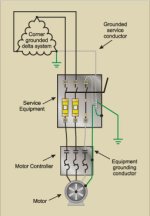This the best I can find for switching the grounded conductor in a grounded delta system is: “ The core principle is that if you’re going to disconnect power to a circuit, you want to ensure that all the conductors carrying current, both phase conductors and the grounded conductor, are interrupted. -Ensuring Complete Isolation.” The best I could find from the internet. Could not find an exact NEC code article dealing with this, but it makes sense from a safety standpoint. If someone has an NEC reference please come forward with the exact code.
View attachment 2579077This the best example I can find for safely handling corner grounded delta. I'am done if you don't want to disconnect the grounded conductor or not it's up to you. I cannot find anything other than this that makes you or suggests you disconnect the grounded conductor in a corner grounded delta system.


